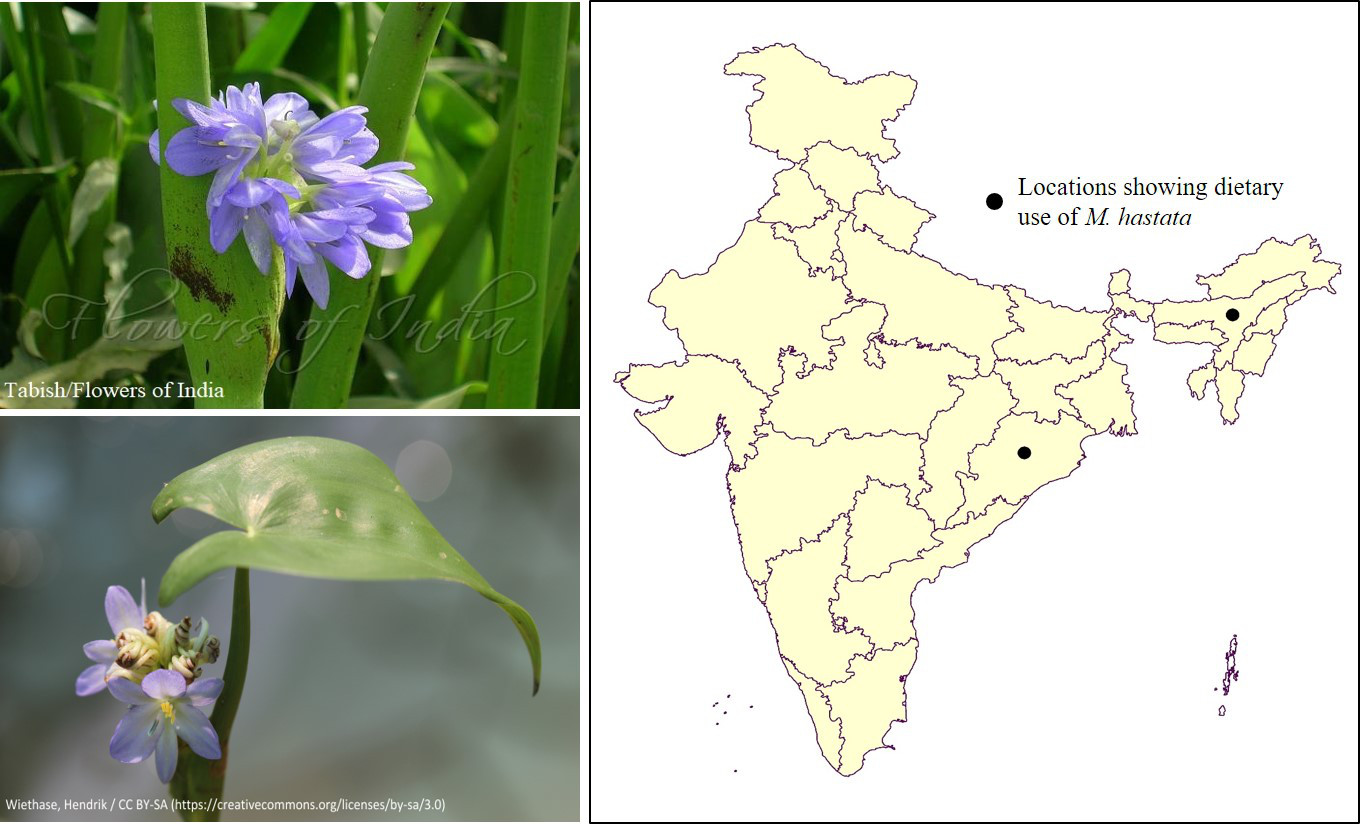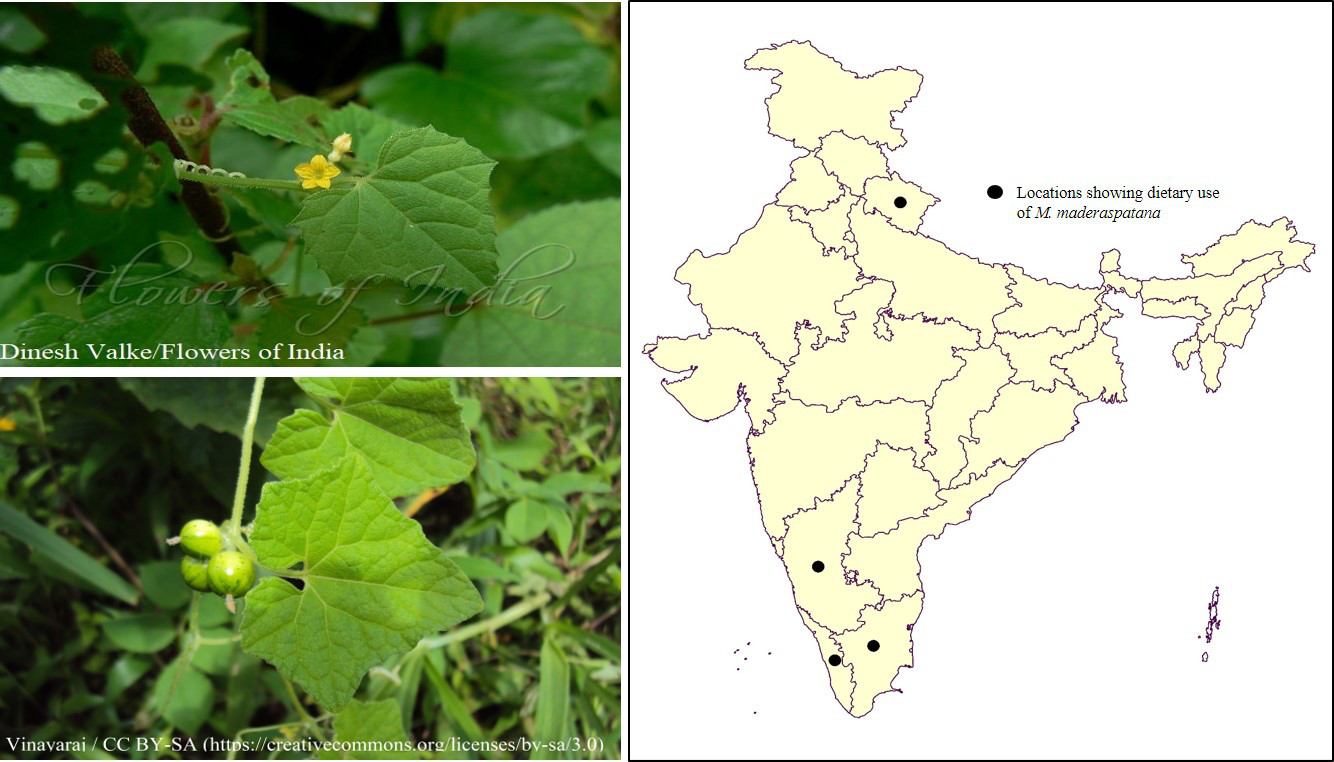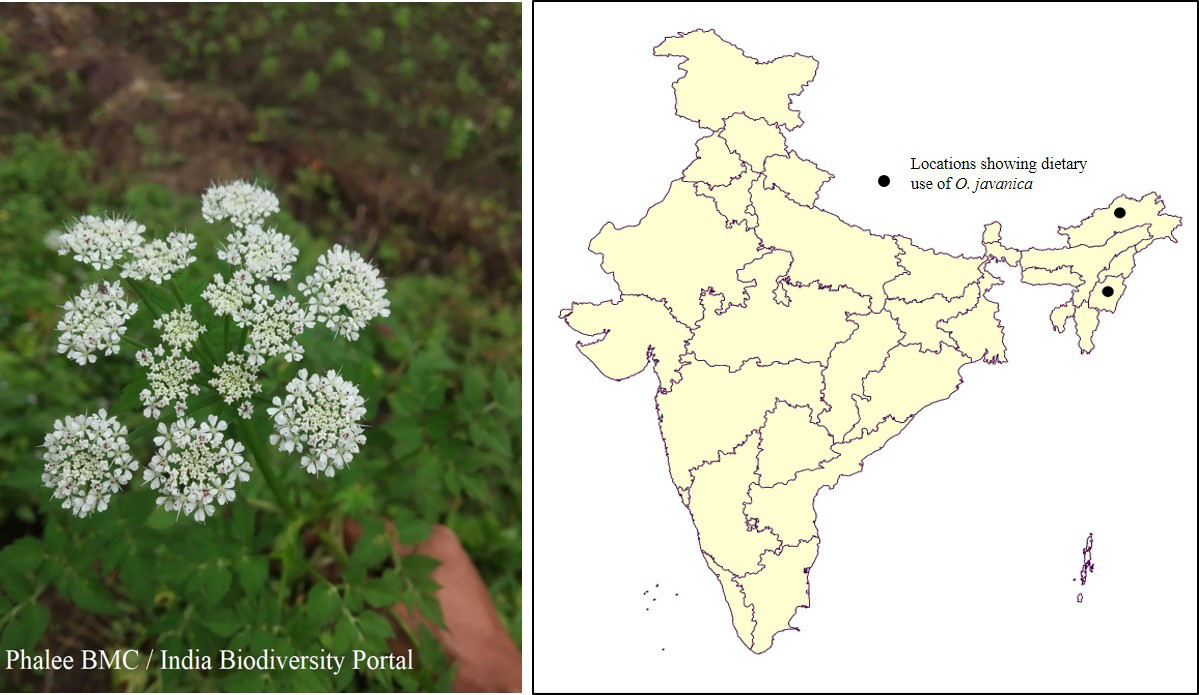Part 6
(……after part 5)
Monochoria hastata (L.) Solms
Family: Pontederiaceae
This aquatic plant is a common weed of the rice fields of India. It is usually seen in shallow waters, erect, and occasionally creeping, with floating leaves and rhizomatous stem. It is only recently that the edibile and the nutritional value of leaves and flowers of this plant are recognized among nutrition enthusiastic. Flowers, leaves and rhizomes are rich in mineral content and are used as alternative green vegetables by rural populations. In Odisha, young inflorescence has also been accepted as food. In Assam, it is called as Bhaat Mateka. The Tai ahom tribes of upper Assam cook it with pork, chicken and fish. It can be used as a vegetable and stir fried with potatoes, green chillies, garlic onion and ginger. The young shoot is also acceptable as food among the Dimasa tribe of the Barak valley of Assam. The ‘pola’ as it is known in the ‘Kuttanad’ region of Kerala is a menace in the shallow water bodies, rice fields, and canals. But nowadays the tribes are earning a decent income as the weeds are bought to feed the ducks and also for making handicrafts.

Mukia maderaspatana (L.) M. Roem.
Family: Cucurbitaceae
The plant belongs to the family of melons, i.e., ‘Cucurbitaceae’. It is a native of India and is an annual. It can be successfully cultivated in the tropical region. It is called as ‘headache vine’ in many parts of the country. In India, it is mostly reported from Kerala, Karnataka and Tamil Nadu. The shoots, leaves and fruits of the plant are edible and eaten after cooking with spices. Due to its anti-diabetic and anti-hypertensive properties the plant is gaining importance among the health conscious diners. It is called as ‘Madras Pea pumpkin’ and the fruit has a combination of sweet and bitter taste. In the south of India, it is made to a paste (Thuvayal) with coconut after saluting with chillies and other spices. Other recipes are like, pieces of leaves mixed with rice, soaked with water and prepare Dosa like item. Similarly, leaves are fried with ghee or gingelly oil, followed by grinding the mass with roasted mixture of coriander leaves, curry leaves, pepper, red chili, dal and salt to make chutney like preparation. The tea prepared from leaf and bark has medicinal use in traditional therapy. The fruits are rich in vitamin C, E, A, phosphorous and minerals. Phytochemical analysis shows the presence of glycoside, flavonoids, phenols, alkaloids, saponin, carbohydrate and steroid in the plant.

Neptunia oleracea Lour
Family: Leguminosae
This plant is gaining popularity among the urban cities across the globe as ‘water mimosa’. It is a perennial nitrogen fixing legume with touch sensitive leaflets. The plant has got the name Neptunia from the God of seas –the Neptune, as it is aquatic in habitat. It floats with the help of the aerenchymatous spongy stem. The branches are harvested when they reach around 30cm in length. The people of Manipur eat the stem after removing the spongy wrap around it. The main delicacies prepared using this plant includes the famous ‘Morokmetpa’, ‘Iromba’, ‘Kanghou’ and ‘Shingju’. Morokmetpa, the chilly salad is made from leaves and fresh shoots. The clean small pieces of plant parts are mixed with boiled king chilli, fermented fish, raw onions and salt. For ‘Iromba’, sliced pieces boiled along with potatoes and petiole of Alocasia odora which is then prepared along with chillies and fermented fish. The dish is garnished with onions, corianders etc. For ‘Kanghou’, the plant parts are fried with other vegetables (brinjal, okra, potato, cabbage etc). ‘Shingju’ is made with papaya and ‘water mimosa’. Some other popular preparations are like, young stems, shoots and leaves of water mimosa are cooked and eaten as stir fries with soy sauce, oyster sauce, fish sauce, chillies, and garlic. It is also used in recipes with noodles, minced chicken or fried fish. The plant is rich in calcium, iron, vitamin A and C. ‘Pheophorbide a’ and its related compounds make this plant a promising antitumor agent. In addition to this, it shows high antioxidant activity too.

Oenanthe javanica (Blume) DC.
Family – Apiaceae
This is the only plant in the ‘Oenanthe‘genus that is not toxic. This plant is called as water dropwort in English, ‘seri’ in Japan and ‘Minari’ in Korea. The plant is cultivated for it’s edible shoots, fruits and roots in China, Japan and India. The plant can be seen in forest floors and in paddy fields upto 1500 m. In India, it’s mainly seen in the eastern states and also in Himachal Pradesh and Uttar Pradesh. The plant is called as Komprek in the north-eastern state of Manipur and used to prepare their traditional cuisines, ‘enroba’ and ‘shingsu’. The young shoots are used for soups and salads. It tastes like carrot tops and celery which makes it a perfect additive in sumptuous soups. The food use of the plant is also reported from Assam. Cuisines made of this plant are widely available in all the Japanese restaurants in Indian Cities. In addition to the excellent edible value it possesses, it also can be used as a fish feed to feed ‘koi fish’. Eugenol – a phyto chemical which can be used as an analgesic is present in the shoots of O. Javanica. The shoots and fruits are also rich in antioxidants which qualify the plant as an ideal candidate for health conscious urban platter. O.javanica has high iron content, followed by calcium, and magnesium, which are useful for patients with mineral deficiency problems.




